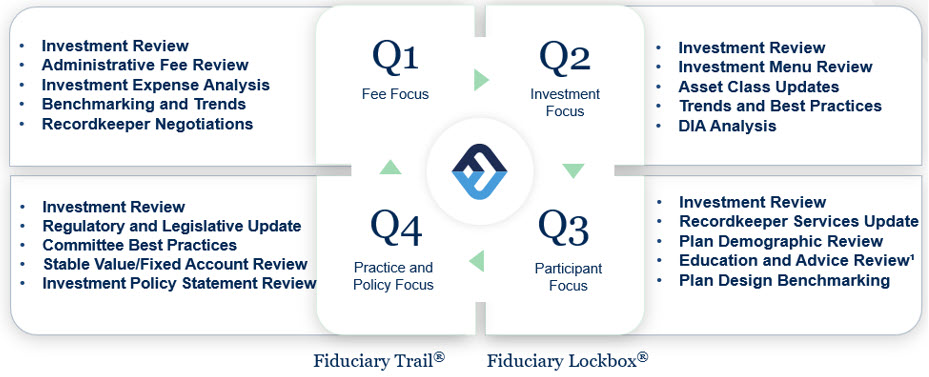Public defined contribution plans have grown in popularity and size in recent years, thanks to robust capital market returns, additional voluntary savings amounts in 457 plans and employee participation in 401(a) plans as opposed to conventional or traditional defined benefit pension plans. Although public defined contribution plans are not subject to ERISA, Plan Sponsors have a fiduciary obligation to prudently oversee these participant-directed investment pools, and many who have taken steps to oversee these plans have experienced significant fee savings, participant service enhancements and administrative benefits.
To help establish a due diligence framework for your defined contribution program, here are a few key aspects to consider:
Governing Body
For those who have never overseen these pools, there may be no current charter stating who, or which committee, has discretionary oversight of these plans. While researching or working with your governing body to determine who should oversee these plans, evaluate peer trends.
There are two routes that sponsors will likely pursue:
- Add the oversight duty to the already-established pension and investment committee.
- Have a separate, smaller committee composed of employees in finance and human resources.
When determining the oversight process, consider the decision-making process. For instance, think about the following:
- Whether to adopt an Investment Policy Statement and/or committee charter
- The benefits of conducting a full review of other governance documents and best practices
Plan Design
Though often overlooked, the design of a participant-directed retirement plan often has a meaningful impact on participation, engagement, savings rates and retirement readiness. Complex plans with multiple vendors, fund menu structures and paper enrollment procedures usually prove to serve as headwinds to employee participation. Plans that are simple to understand offer an easy enrollment process for new employees, enabling reasonable access to savings that encourage participation.
Areas of potential enhancements to improve employee participation and retirement readiness include:
- Consolidation to a single vendor
- Restrictions to the number of outstanding loans allowed
- Assessment of options to streamline transactions to a paperless option through the recordkeeper when possible
Investment Menu Design and Fund Selection
It is not uncommon for defined contribution plans to offer a significant number of fund offerings. More is better, right? Wrong. Behavioral finance studies demonstrated that more fund options are not optimal and can actually deter participation, creating less favorable outcomes.1
While offering a well-diversified fund menu gives participants choices to build their asset allocation to their needs, too much choice can cause undue confusion. A review should be completed with an eye toward behavioral trends as well as any trends or patterns of current participants to determine the optimum number of investments and asset classes to offer in the plan. Once you determine the most advantageous fund menu structure, the next step is to identify compelling managers for each asset class offered. Also, carefully consider including both actively managed and low-cost, passively managed index funds.
Fee Review
In many cases, Plan Sponsors often struggle with the lack of transparency in recordkeeping and administrative fees. A common practice, known as bundling, means recordkeeping and administrative fees are imbedded in the expense ratio/cost of each investment offering. This creates a good deal of confusion at the Plan Sponsor and participant level in terms of understanding what they are paying between recordkeeping and investment fees.
Recently, investment trends indicate more frequent removal of recordkeeping costs in lieu of a level recordkeeping fee across all participant accounts. This process creates a more transparent and equitable allocation of the recordkeeping fees. As such, Plan Sponsors should request a full fee disclosure report from their recordkeeper at least annually. No less than annually, Plan Sponsors should assess the reasonableness of fees to the services being delivered to the plan and its participants.
Plan Sponsors need to take the following steps to ensure fair overhead costs. Specifically, Plan Sponsors should:
- Understand the recordkeeper’s required revenue and how it is allocated across participant accounts (basis point or per head fee).
- Review any revenue sharing agreements between fund companies and the recordkeeper to identify any transactional expenses borne by the participants.
- Lastly, consider the plan’s history of issuing Requests for Proposal (RFPs). If the plan has not conducted an RFP recently, it should consider doing so since an RFP process can help secure the best pricing for recordkeeping services and identify other service models or features that may be beneficial to the plan and its participants.
Participant Communications
Changes to your participant-directed plan will require communication to the plan participants. For some, these changes will be a welcome sight; for others, it can be met with some resistance. When considering making changes to your plan, it is imperative that you give special attention to the messaging. At first, participants may feel that something is being taken away, which could not be further from the truth.
Your messaging needs to assure participants that it is quite the contrary: These changes are designed to serve as enhancements to the participant experience with the goal of improving retirement readiness. Think about developing a communication campaign in advance of any changes, including digital and print communications paired with in-person meetings, and potentially follow-up meetings, provided by the plan recordkeeper. This is an opportune moment to re-engage your plan population in order to encourage further participation. Depending on the labor structure of your community, inviting union representation to observe initial conversations, provide feedback about suggested changes and assist with an effective communication strategy can be beneficial.
Ongoing Oversight
By now, you created an effective governance process, implemented enhancements to plan design, improved fund menu structure, sourced suitable underlying managers and reduced fees while also engaging participants through an effective communication strategy. Now it is time to consider how to ensure your plan stays current with governance best practices. Specifically, you need to make sure your plan and its administrators and participants alike keep informed about any new trends or legislation. To help achieve this, consider adopting an ongoing oversight process that re-evaluates these topics periodically. Be sure that this process fits your needs and capacity. While some may be well-suited by conducting an annual review, others choose to meet more frequently and adopt a governance calendar to help structure their meeting agendas as outlined.

select and monitor participant advice providers.
Please contact your Fiducient Advisors’ Consultant to learn more about how our time-tested and structured process can assist you in creating the best plan for your employees.
Content is made available for informational and educational purposes only and does not represent a specific recommendation. Always seek the advice of qualified professionals familiar with your unique circumstances.
1https://scholar.harvard.edu/files/laibson/files/plan_design_and_401k_savings_outcomes.pdf
The information contained herein is confidential and the dissemination or distribution to any other person without the prior approval of Fiducient Advisors is strictly prohibited. Information has been obtained from sources believed to be reliable, though not independently verified. Any forecasts are hypothetical and represent future expectations and not actual return volatilities and correlations will differ from forecasts. This report does not represent a specific investment recommendation. The opinions and analysis expressed herein are based on Fiducient Advisor research and professional experience and are expressed as of the date of this report. Please consult with your advisor, attorney and accountant, as appropriate, regarding specific advice. Past performance does not indicate future performance and there is risk of loss.


